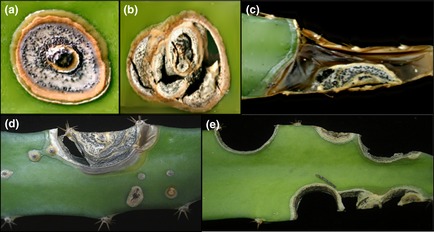Bacterial canker in dragon fruit plants presents a formidable challenge for growers, posing a significant threat to the health and productivity of these exotic succulents. The sneaky invasion of bacterial pathogens is what makes bacterial canker a destructive force that weakens the plant’s structure and physiological functions.
Table of Contents
Bacterial Canker in Dragon Fruit: Causes, Symptoms, and Management

Causes of Bacterial Canker
A group of bacterial pathogens, most notably Ralstonia solanacearum and Xanthomonas campestris pv. hylocereus, are responsible for the onset of bacterial canker in dragon fruit. These insidious invaders capitalize on vulnerabilities within the plant’s defense mechanisms, exploiting wounds, and tissue lesions as gateways for infiltration.
Bacterial canker thrives in environments characterized by high humidity and warm temperatures, fostering the proliferation and dissemination of bacterial pathogens. Inadequate sanitation practices and the introduction of contaminated plant material exacerbate the spread of infection, amplifying the severity of the outbreak.
Symptoms of Bacterial Canker

Identification of bacterial canker in dragon fruit hinges upon astute observation and discernment. Early detection is paramount to implementing effective intervention strategies and curtailing the spread of infection throughout the orchard.
Symptoms of bacterial canker manifest initially as water-soaked lesions along the stems and branches of the plant. As the infection progresses, these lesions evolve into necrotic regions characterized by tissue degradation and discoloration, imparting a ghastly hue upon the afflicted foliage.
Fruit development may be impeded, with symptoms of bacterial canker manifesting as premature fruit drop and internal necrosis. The structural integrity of the fruit is compromised, rendering it unsuitable for consumption and commercialization.
Managing Bacterial Canker

Combatting bacterial canker in dragon fruit demands a concerted effort, encompassing preventive measures and targeted interventions aimed at fortifying the plant’s natural defenses and curbing the spread of infection.
1. Implement Sanitation Protocols
Institute rigorous sanitation protocols to mitigate the spread of bacterial canker within the orchard. Disinfect pruning tools and equipment between use, minimizing the risk of cross-contamination and inadvertent transmission of bacterial pathogens.
2. Practice Cultural Management Techniques
Adopt cultural management techniques to create an inhospitable environment for bacterial canker. Implement crop rotation strategies to disrupt the life cycle of bacterial pathogens and reduce the buildup of inoculum within the soil.
3. Enhance Plant Resistance
Select dragon fruit varieties renowned for their resistance to bacterial canker, prioritizing cultivars that exhibit genetic resilience against bacterial pathogens. Incorporate biocontrol agents and microbial inoculants into the soil to augment the plant’s natural defense mechanisms.
4. Optimize Irrigation Practices
Exercise prudence in irrigation practices to minimize the risk of bacterial canker. Adopt drip irrigation systems to deliver water directly to the root zone, circumventing foliage and mitigating the spread of bacterial pathogens via splashing water droplets.
5. Implement Chemical Treatments
In cases of severe bacterial canker outbreaks, intervention with chemical treatments may be warranted to suppress bacterial proliferation and mitigate the spread of infection. Select bactericides approved for use in dragon fruit cultivation, adhering strictly to recommended application rates and safety precautions.
6. Embrace Vigilance
Maintain vigilant surveillance of the orchard, conducting regular inspections to identify early signs of bacterial canker, and implementing timely intervention measures. Monitor environmental conditions conducive to bacterial proliferation, preempting potential outbreaks through proactive management strategies.
Conclusion
In conclusion, bacterial canker represents a formidable adversary, challenging growers to fortify their defenses and adopt proactive management strategies to safeguard the health and vitality of their orchards. By fostering a culture of vigilance and embracing innovative approaches to disease management, enthusiasts can cultivate thriving ecosystems teeming with the resplendent beauty of dragon fruit. Let us embark on a journey of resilience and stewardship, nurturing our dragon fruit plants to unparalleled heights of vitality and splendour.
